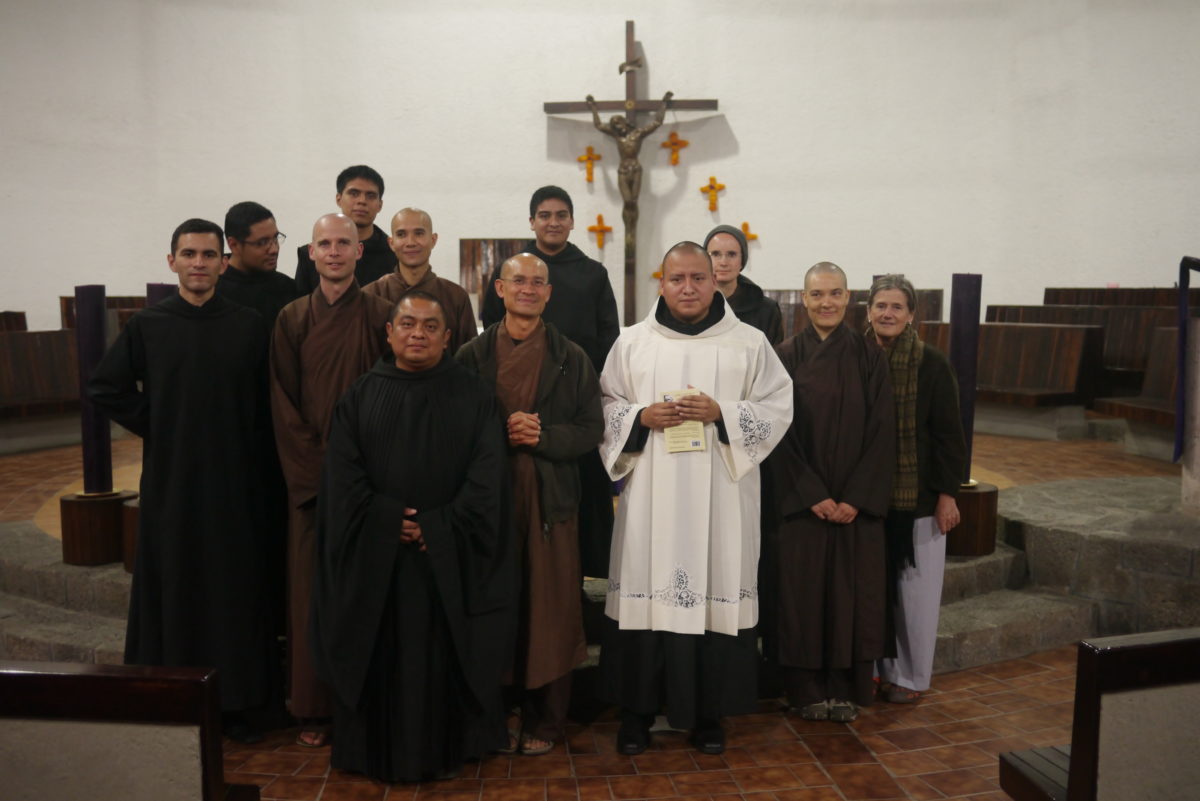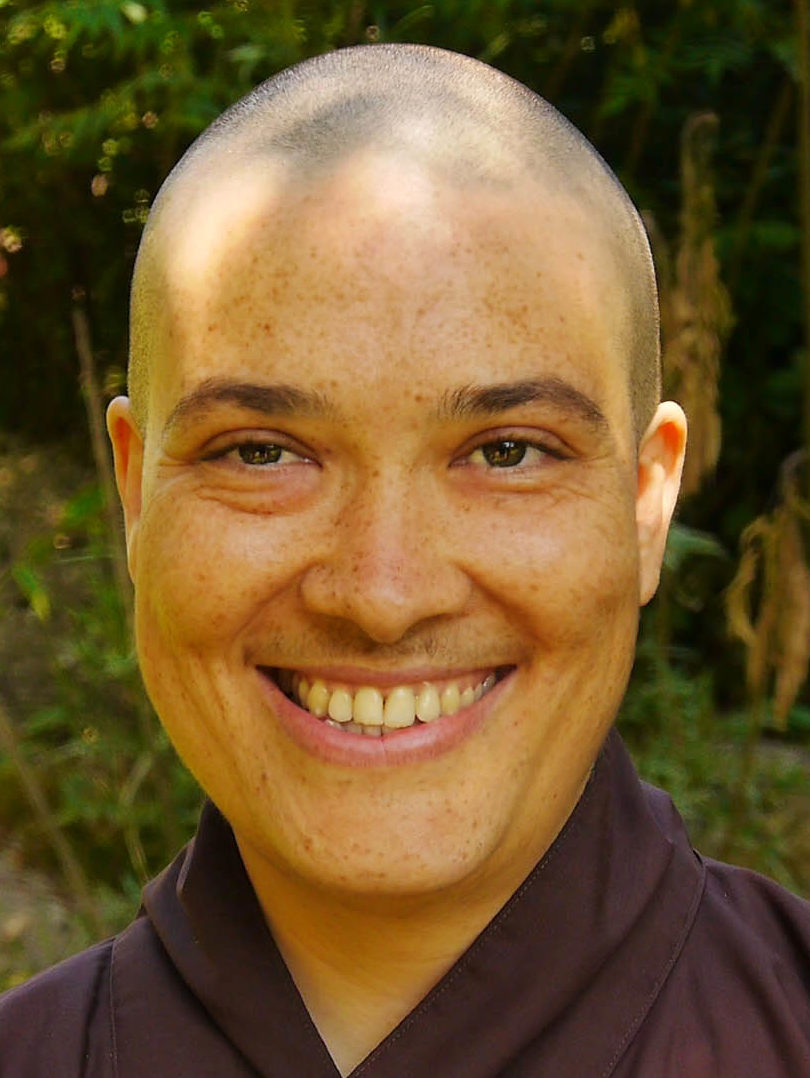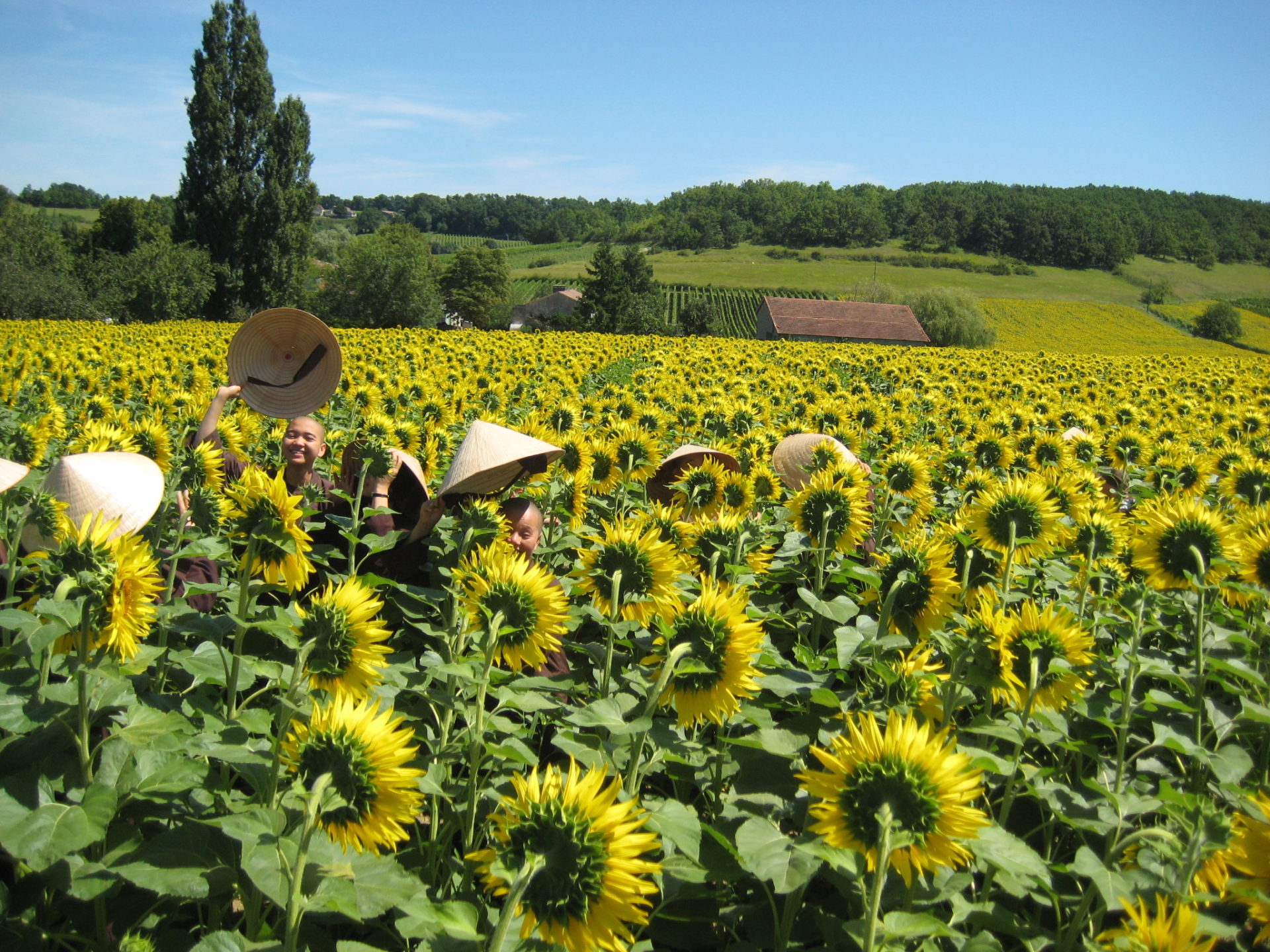A Wake Up Tour in Latin America
By Sister Hai Nghiem (Sister Harmony)

Dear Thay, dear friends!
I am very happy to have the opportunity to share a little bit about a great adventure I took part in last fall, when a mini fourfold Sangha traveled to five countries in Latin America—Chile,
A Wake Up Tour in Latin America
By Sister Hai Nghiem (Sister Harmony)

Dear Thay, dear friends!
I am very happy to have the opportunity to share a little bit about a great adventure I took part in last fall, when a mini fourfold Sangha traveled to five countries in Latin America—Chile, Ecuador, Colombia, Nicaragua, and Mexico—for a Wake Up tour that included public talks, Days of Mindfulness, and retreats. This had been a dream, a seed in the heart of three Spanish-speaking brothers in our community, for ten years already! The seed took its time to sprout, until finally many wonderful conditions came together and the lovely flower opened.
Seven monks and nuns and three lay practitioners formed a group. We didn’t know each other well yet, but I strongly believe that the land of Latin America knew very well who should come. She knew that we would become a real river in the course of six weeks of journeying and practicing together, teaching the Plum Village Dharma doors and rediscovering them through the hearts of thousands of new friends.
Maybe you already know my monastic brothers and sisters Thay Phap Lieu, Phap Luu, Phap Khai, Phap The, Su Co Boi Nghiem, and Su Nghiem, and so I will just introduce the three lay angels who accompanied us. First was Wouter Verhoeven, a filmmaker from Holland who has the talent of mindful filming. During the tour he was always working hard, from the very early morning until very late in the evening, to capture videos of our teachings directly in Spanish, and also to interview people practicing in all five countries. He has the capacity to film the stillness and intimacy of sitting meditation without anyone ever feeling disturbed. In fact we usually didn’t even know that he was standing there with the camera. With countless hours of footage from the tour, he is now preparing a documentary which will make Plum Village practice available to thousands of Spanish-speaking people around the world (see it soon at vivirdespiertos.org/film).
Besides Wouter, we were blessed with the presence of Aurora Conde and Joaquin Carral, a young Mexican couple who have been pillars of the Wake Up Sangha in New York for many years, and who have also started the Latino Sangha, named “Sanghita,” of New York. They are both extremely kind, funny, and committed to the practice. Because they are medical doctors and have the great aspiration to promote the health benefits of veganism to the Latino community, and because (like my brothers and sisters) they love all the exquisite plant foods available in South America, we would often invite them to introduce eating meditation and the Fifth Mindfulness Training on mindful consumption. On top of that, they were tirelessly translating from English to Spanish and the other way around, and guiding sessions of deep relaxation.
CHILE
In Santiago, the capital of Chile, we offered tangerine meditation at least three times, each time guided by a different monk or nun. The funniest one went like this: Brother Phap Khai invited us to recognize the shape, color, and texture of the tangerine and to look deeply into the conditions that had brought it about, such as the tree, the rain, the sun, and the farmer. He then helped us see the hidden potential of the tangerine: “You know, this tangerine can turn into a song because when I eat it, I’m happy, and when I’m happy I might want to compose a song!” Then we went on to slowly peeling—“Let us try not to damage the flesh!”—smelling, smiling, and salivating, placing a section on one’s tongue—“Don’t bite into it yet!”—and masticating carefully, aware of the movements of the tongue and jaws before swallowing.
ECUADOR
On our first day in Ecuador, we were invited to have lunch at Tinku, a lovely permaculture centre in the city of Quito. Marcos welcomed us and introduced the garden, the eco-construction workshops, and the design of the centre, which takes into account all elements, such as wind, rain, sunshine, shade, soil, plants, animals, and humans. Chari and Elisa served us a delicious, vegan Ecuadorian meal that included memorable empanadas filled with spinach, raisins, and garlic. We felt so moved and grateful because of the openness and trust immediately manifested to us: only an hour after meeting us for the first time, Marcos said that, if we wanted, a Sangha in Quito could hold their practice sessions here at Tinku.
That same evening we held an event at Simon Bolivar University, and I’ll always remember the cellular phone mirror exercise taught by Sister Boi Nghiem. “Holding your mobile in front of you while it’s still turned off, you smile at your reflection, then make an angry face and smile again. How do you feel? You can say to yourself ‘I love you’ before making a call to another person. How can we change the world if we don’t have compassion for ourselves? If we want to liberate our mind, to love and be loved, we need a spiritual dimension in all activities of our daily life, especially in the most casual ones like talking on the telephone.” As we were sharing about eating meditation, we found out that in Ecuador, most people are still very fortunate to gather as a family for every meal. That is a big lesson the Ecuadorians taught me!
Later, we took questions from the participants. One of them was a representative of the Ministry of Well-Being (Ministerio del Buen-Vivir—yes, the government of Ecuador has such a department) who called to our attention the issue of increasing rates of violence among teenage boys. Remembering insights that Thay had shared in the past, the brothers and sisters suggested that we should respond to these young people by trying to understand the difficult circumstances that have brought them to such behaviors, and that we do all we can to give them love and attention rather than punishment. Also we strongly encouraged the adults to teach mindfulness and compassion to children from the youngest age and to build safe, loving environments where the seed of violence is no longer watered.
COLUMBIA
One week later, we were already in Colombia. Our visit there was beautiful, friendly, and inspiring. We saw hundreds of people engaged in a spiritual life, in particular young people and families with small children. At the three-day retreat that took place three thousand meters up in the mountains, with hummingbirds flying at the windows all the time, there was a question-and-answer marathon for our brothers and sisters. It was lively and deep at the same time. Among the questions that received the most concise and direct answers: “How to let go of the past?—Breathe.” “How to deal with negative people?—Be positive.” But most importantly, we remember the spirit of togetherness, openness, and humanity pervading the meditation hall that morning. After the last walking meditation, Brother Camilo, a Sangha friend and actor who participates in a UN project of promoting reconciliation, delighted us with his “Mindfoolness” clown show, a hilarious, silent skit about the craziness of our lifestyles and the training of a meditation practitioner.
NICARAGUA
The fourth country, Nicaragua, is the one that marked me the most—probably because of its poverty and its really difficult history over many centuries, which still affects every single Nicaraguan’s daily life. At the same time, the beauty of the land and the people was overwhelming. Brother Phap Lieu said that of all five countries we came to, it is the one that most resembles Vietnam. This is also because of the foods that grow there!
The weekend retreat in Managua was attended mostly by young social workers and activists involved in various efforts to improve their society, such as protecting women against domestic violence, helping street children from very vulnerable backgrounds and situations of risk, and helping women who’ve set up an agricultural cooperative. These activists are bodhisattvas who will continue to breathe and walk in mindfulness to help themselves and their homeland. On the last day, we came together for the symbolic planting of a guava tree, which will grow along with five hundred fruit trees that our delegation offered to the women’s cooperative in Rio Blanco. The trees are a token of compassion for future generations, and their planting is a significant action to offset the carbon emissions due to our flights across the continents.
MEXICO
Finally we arrived in Mexico, already at the final stage of the adventure! The context in which we landed was unexpected and painful: the whole country was rocked by strong emotion after forty-three young people had disappeared. It was like the last drop of water making the cup overflow, because tens of thousands of people have disappeared and have been killed in the past years, presumably by drug traffickers. Because of this situation, in a press conference we introduced the methods of mindful breathing and compassionate listening that are used to take care of strong emotions like anger, fear, and despair. Brother Phap Luu emphasized the importance of building loving communities to prevent and stop the spread of violence, and he took the very inspiring example of Sangha member Maria Gamboa’s film, “Mateo,” which came out in Colombia this year and was nominated for an Oscar.
During the final public retreat, I felt I was standing among my own blood family at every moment. The night of October 31st, we celebrated Dia de los Muertos, the famous Mexican festival of the dead. The retreatants brought photographs and mementos of their relatives and placed them on a traditional altar. We began with a silent recollection of our loved ones, and then had an invocation of the blood ancestors, spiritual teachers, and ancestors of the land who gave all their love and efforts so we could be healthy and happy. Brother Phap Lieu helped us to listen to our ancestors and to request their support and assistance in difficult situations. Nowadays, young people are rarely given the opportunity to connect with themselves and their emotions, not to mention with their ancestors; that is why making an offering of incense on the family altar and following each in-breath and out-breath are ways to bring body and mind together and to unite past, present, and future generations with love and strength. We stood a long time around the sacred fire. Each person burned a piece of paper on which they had written their deepest vow to transform negative habits and to offer more peace for the world. This gesture was symbolic of our trust in the Sangha and the universe to help us realize our most meaningful wish.
JOINING STREAMS
Something else that touches me about the final days in Mexico is the great beauty of melding Western monasticism with Vietnamese Zen monasticism. Of course, it is already something very special to have a mini international community wearing the same robes, whose blood ancestors came from Vietnam, France, the USA, Lebanon, Germany, Eastern Europe, and Madagascar. But in addition to this, the location of the retreat was the Benedictine monastery of Nuestra Senora de los Angeles. It’s a place filled with the energy of God, thanks to the diligent practice, the constant prayers, the generous service, and the open-mindedness of the fourteen Benedictine monks who live there and who accepted to host a Buddhist retreat for 150 people.
As in many previous tours when our Plum Village monastic community was welcomed by Christian monks or nuns, I felt extremely grateful to be able to marry the two traditions in my own practice. In a souvenir shop in Colombia, we were asked whether we were Franciscans, and I think there is really some truth there! It is all the more encouraging for peace in the world to get the feeling that Zen Buddhism can be completely and naturally at home in Latin America.
Another great stream of spirituality nourished each of my steps and breaths on this journey, and it was the wisdom of the native peoples of Latin America. I was struck again and again by the strength of their values, such as their respect for the Earth and for people and other species as parts of the oneness of life, their openness to receiving new understandings every day, their generosity and gratitude. Most of the time without a word exchanged, I felt the true meaning of brotherhood and sisterhood that Thay always wants us to cultivate.
This tour was a gift of happiness for me; it allowed me to grow in my practice of compassion, and I would like to deeply thank Thay, the Sangha, and all the people I met along the way who showed me how to be a better instrument of the Dharma. On the last day, before taking the plane back to France, our filmmaker, Wouter, asked each of us to say one word in Spanish expressing what mindfulness means in our heart. My answer was, “Esperanza.” Hope!

Sister Hai Nghiem (True Adornment with Harmony) was ordained by Thich Nhat Hanh in February 2008. Before joining the Plum Village community, she studied translation (specializing in economy and law) at the University of Grenoble, France, and the Institute of Translation and Interpretation in Heidelberg, Germany. What is most meaningful and fun for her is to use Plum Village practices and love of Mother Nature to nourish gratitude in her heart every day, to understand and heal mental

